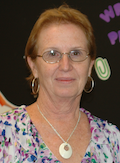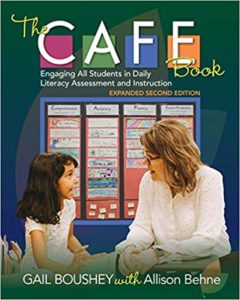The CAFE Book Returns with Fresh Strategies
The CAFE Book: Engaging All Students in Daily Literacy Assessment and Instruction (Expanded second edition)
By Gail Boushey with Allison Behne
(Stenhouse Publishers, 2020 – Learn more)

Welcome to 2020! Welcome to The CAFE Book: Engaging All Students in Daily Literacy Assessment and Instruction (Expanded second edition).
As educators, we are always ready and willing to refine our teaching. We are always on the lookout to become better teachers so our students will be the best that they can be. It takes effort, practice, research, mistakes, and reflection on our successes and our not so successful attempts.
The CAFE Book: Engaging All Students in Daily Literacy Assessment and Instruction was written to help educators on their quest to become even better at their craft, whether they are a novice teacher, a literacy coach, an administrator, or a veteran teacher.

It’s a gathering place, and the CAFE literacy practice reminds me of exactly that. Enjoying the company of peers, teachers, and the joy of reading.
Although the letters in the CAFE acronym represent different words, the premise is the same. We are interacting with friends (books), processing what we are reading, and responding to it. It’s a framework for assessing teaching and accountability. The letters represent the following skills:
- Comprehension
- Accuracy
- Fluency
- Expanded vocabulary
Lots of fresh ideas to support the original concept
The publisher notes that The CAFE Book is meant to help teachers apply what the authors’ research has shown – “that reading instruction is not about the setting, the basal, or the book level. Rather, effective reading instruction is based on what that student needs in that moment.”
For educators who are familiar with the CAFE method of teaching, you will be relieved to know that the core concepts are basically the same, but the updated edition has used teacher feedback, hands-on work with students and teachers, and research to strengthen the practice. The authors also provide more scaffolds to differentiate according to students’ needs and abilities. You will be helping each child become more successful by stimulating their minds to explore their thinking and expand their vocabulary.
Educators new to the CAFE method will find the book extremely well written and organized. There are easy-to-follow strategies to help the teacher assess students, determine what their needs are, and provide the essential instructional supports to make it work!
Welcome to the new expanded edition which includes but is not limited to (p. 4):
- A revised framework that includes the Seven Steps from Assessment to Instruction and the Instructions Protocol
- The addition of CAFE’s Essential Elements, a resource to guide your understanding and implementation
- New and upgraded forms that will help to build more effective conferring with students
- Updated Ready Reference Guides that include identifiers for who may need the strategy, language we use when teaching the strategy, and strategies to use while working in a partnership.
Understanding teachers’ learning styles as well as students’
What is especially beneficial and unique about this book is that it takes into account the learning styles of teachers. Can you imagine that! The authors worked diligently to engage with teachers, seeking insights of their successes and needs as they implemented the program into classrooms. The book is full of anecdotes that teachers have shared, stories, charts, tips, and helpful resources. The content is actually differentiated according to various educator styles of teaching.
For example, we know how critical assessment is in our daily teaching practice. Taking meaningful conference notes and acting on them can be overwhelming and time consuming, but it’s an essential practice. Paper or online assessments? The authors generously provide resources for the technology-oriented teacher, the teacher who finds is more comfortable using paper/pen to take notes, or the teacher who wants to work with a bit of both.
What you will find, by chapter
To me, the book reads like a great novel. Sometimes when I read a book that is especially well written, I want to go back and reread a section because the words are so meaningful and empowering. Each chapter in this book captures your interest:
- What is CAFE?
- The CAFE Conferring Notebook: Accountability for Our Teaching and Student Learning
- Assessment: The Foundation of Intentional Instruction
- The Instruction Protocol: Designing Student-Centered Lessons
- Getting Started
- Frequently Asked Questions
In the past when I read a book about teaching and wanted to implement a new concept or strategy, I had a million and one questions: Where do I begin? Should I teach all the strategies, or can I pick and choose? What if….? How do I differentiate? My district wants me to post letter grades; can I use this approach? Where can I go for support?
The authors have thought ahead and have included many possible questions and comprehensive answers (remember that they asked teachers in the classroom for their input). If you still have questions, the Daily CAFE Website is jampacked with videos, articles, printables, and resources added weekly.
A rich resource to to support student reading
The CAFE Book: Engaging All Students in Daily Literacy Assessment and Instruction is full of practical advice, strategies to apply in the classroom, and examples of forms that you can use to provide a successful student-driven reading program. It is a strategy that you can institute in your classroom without expensive materials or scripted lessons.
Welcome to the updated edition of the CAFE book! I guarantee you that will enjoy every minute of reading the book and applying its strategies into your daily teaching repertoire.
After teaching fourth graders for many years, Linda Biondi is supervising preservice and student teachers at The College of New Jersey and Rider University. Last summer she co-facilitated a week-long writing institute in conjunction with the National Writing Project at Rider University. She volunteers for two service organizations: Homefront and Dress for Success of Central New Jersey – both have a mission to end poverty and homelessness. The mission of Dress for Success is to empower women to achieve through economic independence.






























